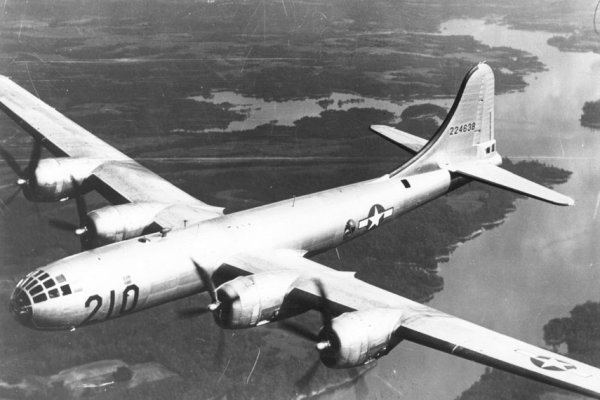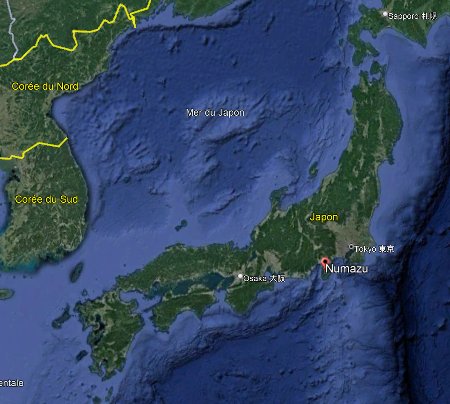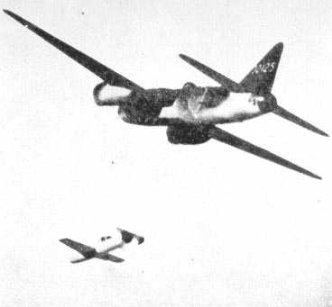ACUFO-1945-07-17-NUMAZU-2
The Tactical Mission report for Missions 271-274 of the night of July 16 to 17, 1945, of the U.S. Army Air Forces, noted among the cases of “balls of fire” sightings:
(4) One aircraft observed a red light high at 6 o'clock. This red light passed to the right of the B-29 making sharp turns. At the time of this observation tracer fire was being directed at the B-29 from the ground.
This was cited in ufological catalogs, referring to this same source, in the 2000s.
The report noted that this occurred during Mission 271, July 16-17, 1945, over the urban area of Numazu, Japan. This raid was carried out by 119 B-29s from the 58th Bombardment Wing, at night, between 01:13 a.m. local and 02:52 a.m. local time, with flight altitudes of 10,600 - 11,600 feet. The planes had taken off from Iwo Jima and returned there. There was a total cloud cover under the planes.
The report states that anti-aicraft activity was weak and inaccurate and that several ineffective searchlights were seen trying to break through the cloud cover.
The report also noted, for the same or another “ball of fire”:
(2) One B-29 reported sighting a “ball of fire” in the vicinity of the target at an altitude of 10,000 feet. The “ball of fire” followed the plane level and seemed to be gaining, when it disappeared into smoke on the right of the B-29.
And also:
(1) Although 21 aircraft were seen none attacked. One crew reported sighting an aircraft believed to be a Betty between the initial point and the target. The Betty flew from 7 to 11 o'clock level at 10,000 feet. It was seen to release what was believed to be a Baka from about 11 o'clock level. The supposed Baka flashed past the B-29 from 11 o'clock to 7 o'clock and then was observed exploding in the distance. No jet was observed. The B-29 gunners did not fire at the objet.
And finally:
(3) One light was seen on the bomb run at 10,800 feet. This was observed 500 feet above the B-29 and seemed to be gaining. When within 500 feet of the B-29 the light went off and turned to the right and disapeared. In the opinion of the interrogation officer the sharp maneuvers engaged in by the light which folllowed the B-29 failed to support the Baka theory.
| Date: | July 17, 1945 |
|---|---|
| Time: | Between 01:13 a.m. and 02:52 a.m. |
| Duration: | ? |
| First known report date: | July 17, 1945 |
| Reporting delay: | Hours. |
| Country: | Japan |
|---|---|
| State/Department: | Shizuoka |
| City or place: | Numazu |
| Number of alleged witnesses: | 1 or more. |
|---|---|
| Number of known witnesses: | ? |
| Number of named witnesses: | 0 |
| Reporting channel: | Military Intelligence report. |
|---|---|
| Visibility conditions: | Night. |
| UFO observed: | Yes. |
| UFO arrival observed: | ? |
| UFO departure observed: | Yes. |
| UFO action: | Passed to the right of the plane, making sharp turns. |
| Witnesses action: | |
| Photographs: | No. |
| Sketch(s) by witness(es): | No. |
| Sketch(es) approved by witness(es): | No. |
| Witness(es) feelings: | ? |
| Witnesses interpretation: | ? |
| Sensors: |
[X] Visual: 1 or more.
[ ] Airborne radar: [ ] Directional ground radar: [ ] Height finder ground radar: [ ] Photo: [ ] Film/video: [ ] EM Effects: [ ] Failures: [ ] Damages: |
|---|---|
| Hynek: | NL |
| Armed / unarmed: | Armed, 12 Browning M2 12,7 mm machine guns. |
| Reliability 1-3: | 3 |
| Strangeness 1-3: | 2 |
| ACUFO: | Unidentified. |
[Ref. aaf1:] U.S. ARMY AIR FORCES:
A report noted what follows, as having occurred during Mission 271, on 16-17 July 1945, over the Numazu Urban Area, Japan.
This raid was performed by 119 B-29's of the 58th Bombardment Wing, in the night, between 1613Z (01:13 a.m. local time) and 1752Z (02:52 a.m. local time), with flight altitudes 10 600 - 11 600 feet. The planes took off from Iwo Jima and landed back there. There was a 10/10 undercast.
Flak was meager and inaccurate and several ineffective searchlights were seen trying to pierce the undercast.

|
(4) One aircraft observed a red light high at 6 o'clock. This red light passed to the right of the B-29 making sharp turns. At the time of this observation tracer fire was being directed at the B-29 from the ground.
The above is was cited in the UFO literature. It should be noted that another crew reported:

|
(1) Although 21 aircraft were seen none attacked. One crew reported sighting an aircraft believed to be a Betty between the initial point and the target. The Betty flew from 7 to 11 o'clock level at 10,000 feet. It was seen to release what was believed to be a Baka from about 11 o'clock level. The supposed Baka flashed past the B-29 from 11 o'clock to 7 o'clock and then was observed exploding in the distance. No jet was observed. The B-29 gunners did not fire at the objet.
And:

|
(2) One B-29 reported sighting a “ball of fire” in the vicinity of the target at an altitude of 10,000 feet. The “ball of fire” followed the plane level and seemed to be gaining, when it disappeared into smoke on the right of the B-29.
And also, this sighting; which was picked up by ufologists as another UFO case:

|
(3) One light was seen on the bomb run at 10,800 feet. This was observed 500 feet above the B-29 and seemed to be gaining. When within 500 feet of the B-29 the light went off and turned to the right and disapeared. In the opinion of the interrogation officer the sharp maneuvers engaged in by the light which folllowed the B-29 failed to support the Baka theory.
[Ref. prt4:] JAN ALDRICH - "PROJECT 1947":
N - 1945.07.16/17 - Night, Numazu, Japan.
B-29, 58th Wings, Mission #271, a red light at the 6 o'clock position. The light passed to the right of aircraft making sharp turns. B-29 crew received flak from the ground at this time. (Mission 271-274 16/17 July 1945, HQ 21st Bomber Command)
[Ref. dwn1:] DOMINIQUE WEINSTEIN:
At night the pilot of a B-29 of the 58th Wing (mission #271) observed a red light at 6 o'clock position which passed to the right of the aircraft making sharp turns. The crew of the B-29 received flak from ground at that time.
Sources: Project 1947, Jan Aldrich/ Mission 271-274, 16-17 July 1945, HQ 21st Bomber Command.
[Ref. dwn2:] DOMINIQUE WEINSTEIN:
At night the pilot of a B-29 of the 58th Wing (mission #271) observed a red light at 6 o'clock position which passed to the right of the aircraft making sharp turns. The crew of the B-29 received flak from ground at that time.
Sources: Project 1947, Jan Aldrich / Mission 271-274, 16-17 July 1945, HQ 21st Bomber Command.
The Boeing B-29 “Superfortress” was the heaviest bomber of the U.S. Army Air Forces, used in operations from May 8, 1944 and on. Its maximum speed was 574 km/h.
Its defensive armament was 12 Browning M2 12.7 mm machine guns.

|

|
As often in these reports, it is rather hard to form an opinion on what was reported.
Because at the time the red light was seen the Japanese flak was firing at the B-29, one may think it was some device used by the Japanese to direct the flak to the B-29. But there was a 10/10 undercast below the B-29, so that the flak fire was likely coincidental to the red light. While it is documented that sometimes the Japanese used a fighter plane equipped with a headlight to designate a B-29 to the flak, such a headlight had no obvious reason to be of red color.
US Intelligence at the time thought that the “balls of fire” may have been the Japanese “Baka” piloted rocket flying bomb.
We do have this report: “One crew reported sighting an aircraft believed to be a Betty” Japanese bomber “between the initial point and the target. The Betty flew from 7 to 11 o'clock level at 10,000 feet. It was seen to release what was believed to be a Baka from about 11 o'clock level. The supposed Baka flashed past the B-29 from 11 o'clock to 7 o'clock and then was observed exploding in the distance. No jet was observed. The B-29 gunners did not fire at the objet.” This may or may not be the same red light than in the report dealt with in this file.
But US Intelligence discarded it: “One light was seen on the bomb run at 10,800 feet. This was observed 500 feet above the B-29 and seemed to be gaining. When within 500 feet of the B-29 the light went off and turned to the right and disapeared. In the opinion of the interrogation officer the sharp maneuvers engaged in by the light which folllowed the B-29 failed to support the Baka theory.”
Historically, there is no evidence at all that the Japanese dropped any “Baka” in the night and against the B-29s. There were only drops in daylight against much more valuable targets, the US battleships. So, while it is only reasonable that the US airmen and Intelligence thought of the “Baka” as a possible explanation of some “balls of fire” seen during their bombing raids over Japan, this explanation should probably be discarded.
Another factor against the “Baka” theory is of course that, as in this case, there was no attack of the B-29. Here we have the red light passing “to the right of the B-29 making sharp turns”. if it was a “Baka”, it should have headed to the B-29. Also, the “Baka” was not able to perform “sharp maneuvers”.
Yet another factor is that the “Baka” had a maximal speed of 1040 km/h and a cruising speed of 840 km/h, much more than the B-29. The airmen should have noticed reported this very high speed, at least occasionally, but they never did.
About Japanese Jet planes:
The report noted that no (Japanese) jets were seen during the mission. At the time, it was sensible to suspect that the Japanese air forces would start using jet planes, as the Germans gave them the technical information about their Messerschmitt Me-262 jet fighter. But the Japanese then only managed to build 2 prototypes, only 1 of them flew, and was never used in operations. This means that the potential UFO reported here cannot have been a jet plane.
About the “Baka”:
The Yokosuka MXY-7 Ohka was a Japanese rocket plane used for suicide “Kamikaze” missions at the end of World War II. It carried an explosive charge of 1,200 kg, constituting a flying bomb, it was dropped from the belly of a twin-engine Mitsubishi G4M “Betty” bomber. Guidance was provided by the pilot alone, the machine flew at 900 km/h and was not very maneuverable, it is known that many “Baka” had exploded in flight before reaching their target. The first use took place on March 16, 1945, the last recorded use took place on June 22, 1945.
In historical sources, all “Baka” attacks were carried out by day and against ships. I haven't found any mention of a nighttime “Baka” attack on bombers.
Below: photo of the drop of a “Baka” by a Japanese bomber, by day:

|
All this means that I have serious doubts about the possibility that the red light was any Japanese craft or device. On the other hand, things are neither clear enough nor strange enough for me to be able to say with certainty that it was an extraterrestrial craft. This possibility seems more likely to me when i consider the “balls of fire” reported by the B-29 crews bombing Japan as a whole, in which one can better see a global and truly intriguing phenomenon.
Unidentified.
* = Source is available to me.
? = Source I am told about but could not get so far. Help needed.
| Main author: | Patrick Gross |
|---|---|
| Contributors: | None |
| Reviewers: | None |
| Editor: | Patrick Gross |
| Version: | Create/changed by: | Date: | Description: |
|---|---|---|---|
| 0.1 | Patrick Gross | MAy 1, 2024 | Creation, [aaf1], [prt4], [dwn1], [dwn2]. |
| 1.0 | Patrick Gross | MAy 1, 2024 | First published. |